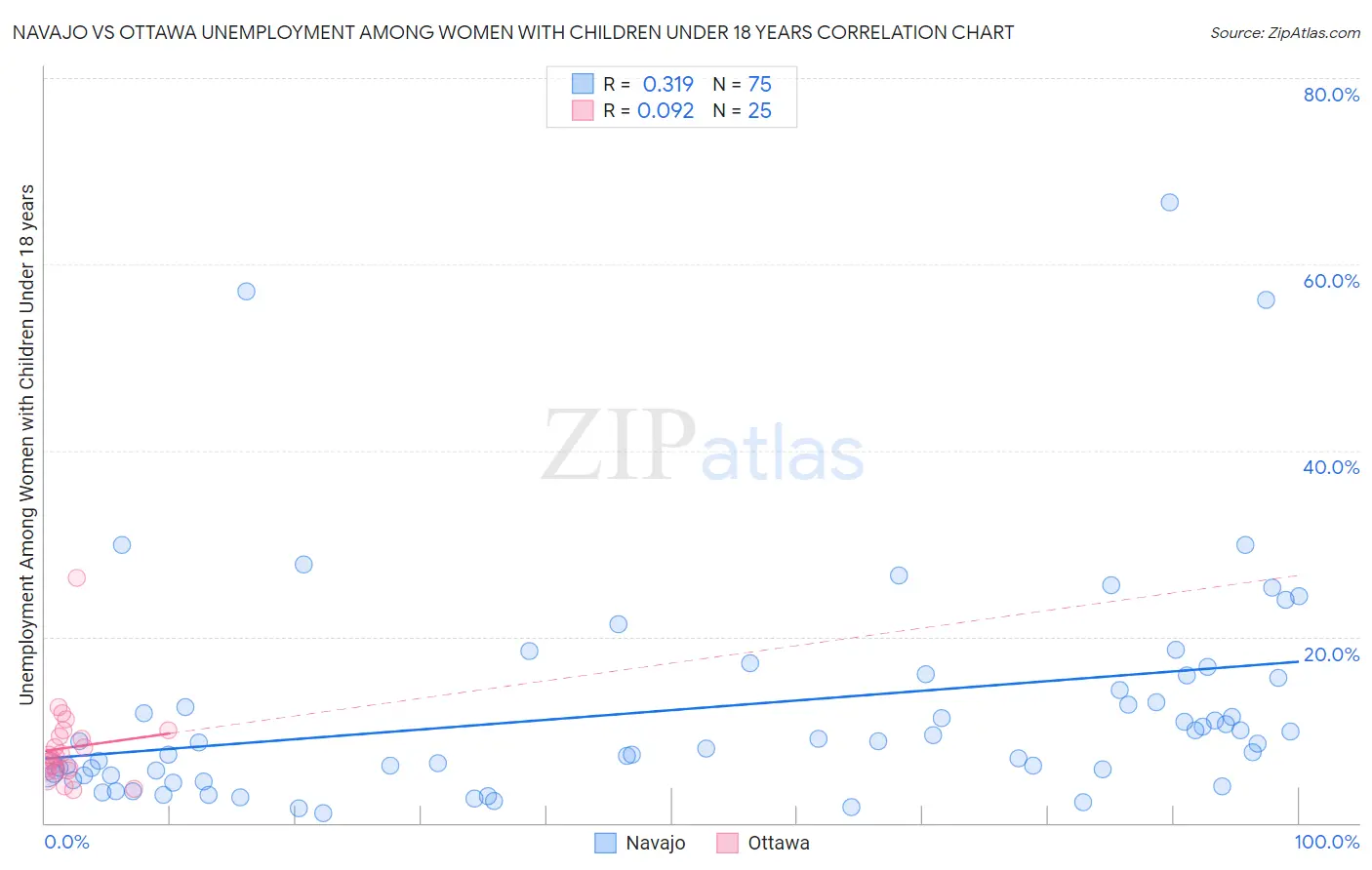Navajo vs Ottawa Unemployment Among Women with Children Under 18 years
COMPARE
Navajo
Ottawa
Unemployment Among Women with Children Under 18 years
Unemployment Among Women with Children Under 18 years Comparison
Navajo
Ottawa
8.2%
UNEMPLOYMENT AMONG WOMEN WITH CHILDREN UNDER 18 YEARS
0.0/ 100
METRIC RATING
339th/ 347
METRIC RANK
6.1%
UNEMPLOYMENT AMONG WOMEN WITH CHILDREN UNDER 18 YEARS
0.1/ 100
METRIC RATING
259th/ 347
METRIC RANK
Navajo vs Ottawa Unemployment Among Women with Children Under 18 years Correlation Chart
The statistical analysis conducted on geographies consisting of 218,816,845 people shows a mild positive correlation between the proportion of Navajo and unemployment rate among women with children under the age of 18 in the United States with a correlation coefficient (R) of 0.319 and weighted average of 8.2%. Similarly, the statistical analysis conducted on geographies consisting of 49,047,550 people shows a slight positive correlation between the proportion of Ottawa and unemployment rate among women with children under the age of 18 in the United States with a correlation coefficient (R) of 0.092 and weighted average of 6.1%, a difference of 34.3%.

Unemployment Among Women with Children Under 18 years Correlation Summary
| Measurement | Navajo | Ottawa |
| Minimum | 1.1% | 3.6% |
| Maximum | 66.7% | 26.3% |
| Range | 65.6% | 22.7% |
| Mean | 12.2% | 8.1% |
| Median | 8.7% | 7.1% |
| Interquartile 25% (IQ1) | 5.2% | 5.6% |
| Interquartile 75% (IQ3) | 15.6% | 9.6% |
| Interquartile Range (IQR) | 10.4% | 4.0% |
| Standard Deviation (Sample) | 12.3% | 4.5% |
| Standard Deviation (Population) | 12.2% | 4.4% |
Similar Demographics by Unemployment Among Women with Children Under 18 years
Demographics Similar to Navajo by Unemployment Among Women with Children Under 18 years
In terms of unemployment among women with children under 18 years, the demographic groups most similar to Navajo are Crow (8.2%, a difference of 0.20%), Immigrants from Yemen (8.2%, a difference of 0.52%), Yakama (8.1%, a difference of 2.1%), Sioux (7.9%, a difference of 3.6%), and Apache (7.9%, a difference of 3.9%).
| Demographics | Rating | Rank | Unemployment Among Women with Children Under 18 years |
| Dominicans | 0.0 /100 | #332 | Tragic 7.5% |
| Immigrants | Dominican Republic | 0.0 /100 | #333 | Tragic 7.5% |
| Cheyenne | 0.0 /100 | #334 | Tragic 7.8% |
| Apache | 0.0 /100 | #335 | Tragic 7.9% |
| Sioux | 0.0 /100 | #336 | Tragic 7.9% |
| Yakama | 0.0 /100 | #337 | Tragic 8.1% |
| Immigrants | Yemen | 0.0 /100 | #338 | Tragic 8.2% |
| Navajo | 0.0 /100 | #339 | Tragic 8.2% |
| Crow | 0.0 /100 | #340 | Tragic 8.2% |
| Tohono O'odham | 0.0 /100 | #341 | Tragic 8.9% |
| Puerto Ricans | 0.0 /100 | #342 | Tragic 9.0% |
| Arapaho | 0.0 /100 | #343 | Tragic 9.2% |
| Inupiat | 0.0 /100 | #344 | Tragic 9.6% |
| Yuman | 0.0 /100 | #345 | Tragic 9.8% |
| Yup'ik | 0.0 /100 | #346 | Tragic 11.0% |
Demographics Similar to Ottawa by Unemployment Among Women with Children Under 18 years
In terms of unemployment among women with children under 18 years, the demographic groups most similar to Ottawa are Nigerian (6.1%, a difference of 0.020%), Immigrants from Liberia (6.1%, a difference of 0.12%), Immigrants from Trinidad and Tobago (6.1%, a difference of 0.12%), Spanish American Indian (6.1%, a difference of 0.14%), and Comanche (6.1%, a difference of 0.21%).
| Demographics | Rating | Rank | Unemployment Among Women with Children Under 18 years |
| Seminole | 0.5 /100 | #252 | Tragic 6.0% |
| Immigrants | Congo | 0.4 /100 | #253 | Tragic 6.0% |
| Immigrants | Azores | 0.3 /100 | #254 | Tragic 6.0% |
| Liberians | 0.2 /100 | #255 | Tragic 6.0% |
| Nepalese | 0.2 /100 | #256 | Tragic 6.0% |
| Bermudans | 0.1 /100 | #257 | Tragic 6.1% |
| Immigrants | Nigeria | 0.1 /100 | #258 | Tragic 6.1% |
| Ottawa | 0.1 /100 | #259 | Tragic 6.1% |
| Nigerians | 0.1 /100 | #260 | Tragic 6.1% |
| Immigrants | Liberia | 0.1 /100 | #261 | Tragic 6.1% |
| Immigrants | Trinidad and Tobago | 0.1 /100 | #262 | Tragic 6.1% |
| Spanish American Indians | 0.1 /100 | #263 | Tragic 6.1% |
| Comanche | 0.1 /100 | #264 | Tragic 6.1% |
| Immigrants | Bahamas | 0.1 /100 | #265 | Tragic 6.1% |
| Sub-Saharan Africans | 0.1 /100 | #266 | Tragic 6.2% |